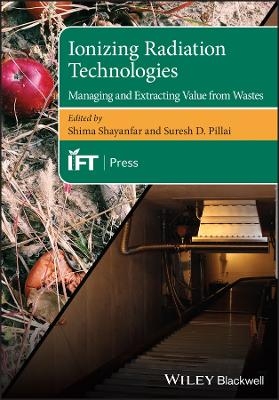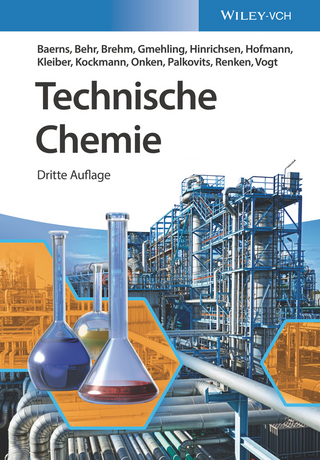
Ionizing Radiation Technologies
Wiley-Blackwell (Verlag)
978-1-119-48853-8 (ISBN)
In Ionizing Radiation Technologies: Managing and Extracting Value from Wastes, a team of expert researchers delivers a broad overview of the value trapped in waste streams and how a strategic application of ionizing radiation technologies can be valuable from both an environmental and an economic perspective. A valuable addition to the discussions around sustainability and green technologies, the book introduces ionizing radiation technologies, including gamma (cobalt-60) irradiation and high and low energy electron beam technologies.
The contributions included explore the major advances taking place in the application of ionizing radiation technologies to derive high value end-products from agricultural, municipal, and industrial wastes. Each chapter reviews original research and data and considers likely future directions in research and development. The book also includes:
A thorough introduction to the application of ionizing radiation technologies to agricultural waste, including the production of activated carbon
Comprehensive explorations of the application of ionizing radiation technologies to municipal waste, including municipal solid wastes and recycling wastewater
Practical discussions of the application of ionizing radiation technologies to industrial waste, including textile wastewater management and polymer recycling
In-depth examinations of the economics of waste valorization, including several case studies of businesses involved in waste valorization
Perfect for consulting engineers and industry professionals involved in waste management and mitigation, Ionizing Radiation Technologies will also earn a place in the libraries of professionals at government agencies, international food organizations, and NGOs focused on waste management, environment sustainability, and urban planning.
About the Editors Shima Shayanfar, Research and Development Scientist, Herbalife Nutrition U.S., California, USA. Suresh D. Pillai, Director of the National Center for Electron Beam Research, and Professor of Microbiology, Texas A&M University, Texas, USA.
Contents
List of Contributors xi
Preface xiv
Acknowledgments xvi
1 Introduction 1
Shima Shayanfar and Suresh D. Pillai
References 3
2 Radiation Processing Using Cobalt-60 Gamma Rays 4
Kevin O’Hara
2.1 Introduction 4
2.2 Overview of Cobalt-60—The Radiation Source 4
2.3 Overview of Cobalt-60 Gamma Technology 5
2.4 Cobalt-60 Safety and Security 9
2.5 The Future of Cobalt-60 Gamma Technology 10
References 10
3 X-ray Technology 12
Jeremy Brison, Rick Galloway, Christophe Malice, and Josef Mittendorfer
3.1 Introduction to X-ray Technology 12
3.2 Physical Properties of X-rays 14
3.3 X-rays Today 21
3.4 The X-ray Vision 36
References 37
4 Low-Energy Electron Beam Technologies: Deriving Value from Waste 39
P. Michael Fletcher
4.1 Introduction and History 39
4.2 Ranges of Energy for Electron Accelerators 40
4.3 Shielding Considerations 41
4.4 Absorption of Electron Energy by Materials 42
4.5 Absorption of Electrons’ Negative Charges by Materials 45
4.6 Predicting Depth of Electron Penetration into Products 45
4.7 Dose Measurements and Machine Characterization 46
4.8 Equipment Supplier Brief History 47
4.9 Low-Energy EB Applications 49
4.10 X-ray Shielding and Product Processing 51
4.11 Low-Energy X-ray Machines Made from Low-Energy EB Machines 52
References 52
5 Accelerator Technology for Waste Valorization 53
David Brown
5.1 Introduction 53
5.2 General Properties of the Electron Beam 56
5.3 Delivering “Dose” to Materials 57
5.4 Integration of Accelerator Technologies into Waste Processing Facilities 59
5.5 Integration of E-Beam Systems—An Overview (or “How to Speak to an Accelerator Supplier”) 59
5.6 Process Design, Accelerator Specification, and Machine Selection 60
5.7 Staffing Considerations for Waste Processing Facilities 61
5.8 It’s All about the Dose to the Product 63
5.9 An Overview of Radiation Processing Standards Related to Machine-Based Sources 68
Reference 78
6 Biofuel Production Using Ionizing Technology from Agricultural Waste 79
Tan Kean Meng and Mohd Asyraf Kassim
6.1 Introduction 79
6.2 Agriculture Waste 80
6.3 Biofuel 81
6.4 Pretreatment 82
6.5 Ionizing Radiation 83
6.6 Effect of Ionizing Radiation Pretreatment 87
6.7 Bioethanol 90
6.8 Biomethane 91
6.9 Biohydrogen 93
6.10 Conclusions 94
References 95
7 Ionizing Technology Effects on Bioactive Compounds from Food Products 104
J.R. Rodríguez-Núñez, A. Rodríguez-Félix, P. I. Campa-Siqueiros, L. Val-Félix,
and T.J. Madera-Santana
7.1 Introduction 104
7.2 Valorization of Food Wastes 105
7.3 Food Components: Bioactive Compounds 105
7.4 Bioactive Compounds in Food Subjected to Ionizing Radiation 106
7.5 Conclusions 113
References 113
8 Remediation of Crude Oil Impacted Soils with Electron Beam Irradiation 120
John Lassalle, Kenneth Briggs, Thomas Thompson, Marco Martinez, Andrea Strzelec,
and David Staack
8.1 Introduction 120
8.2 Demand for Novel Remediation Techniques 121
8.3 Potential Advantages of Electron Beam Remediation 122
8.4 Process Implementation 124
8.5 Economic Feasibility 131
8.6 Comparison to Other Remediation Technologies 132
8.7 Conclusions 133
References 134
9 Application of E-beam Irradiation to Enhance Class B Disinfection Biosolids Processes to Class A Disinfection Treatment to Produce Value-Added Products 136
Robert S. Reimers, Yue Xu, Suresh D. Pillai, and Kari B. Fitzmorris-Brisolara
9.1 Introduction 136
9.2 Enhanced Anaerobic Digestion 138
9.3 Application of eBeam to Enhance Anaerobic Digestion 139
9.4 Rationale for Upgrading Class B Plants to Class A 141
9.5 Value-Added Products 145
9.6 Value-Added Product Examples 145
9.7 Conclusions 147
References 148
10 Textile Wastewater Management by Ionizing Technology 150
Weihua Sun, Wenyi Wang, and Youxue Zhang
10.1 Introduction 150
10.2 Characteristics of Textile Wastewater 150
10.3 Mechanisms and Influencing Factors of Treating Textile Wastewater by Ionizing Radiation 152
10.4 Ionizing Radiation Applied on Textile Wastewater Management 161
10.5 Conclusions 176
References 177
11 Using Ionizing Technologies on Natural Compounds and Wastes for the Development of Advanced Polymers and Active Packaging Materials 180
S. Salmieri, Leila Bagheri, and Monique Lacroix
11.1 Introduction 180
11.2 Combination of Active Packaging with Gamma Irradiation 182
11.3 Development of Active Packaging Using Gamma Irradiation 186
11.4 Conclusions 203
References 204
12 Treatment of Emerging Organic Pollutants Using Ionizing Technology—A State of the Art Discussion 210
Yongxia Sun, Andrzej G. Chmielewski, and Henrietta Nichipor
12.1 Introduction 210
12.2 Methodology 211
12.3 Main Factors Influencing Degradation of EOP 211
12.4 By-products of Selected Aromatic EOP Degradation under Ionizing Radiation 212
12.5 Toxicity of the Solution Containing Selected Aromatic EOPS Before and After Ionizing Radiation 214
12.6 Computer Simulation of Emerging Persistent Pollutant Perfluorooctanoic Acid (PFOA) Degradation under Electron Beam and Gamma Ray Radiation 215
12.7 Conclusions 221
References 221
13 Remediation of Poly- and Perfluorinated Chemical Substances (PFAS) in the Environment by Ionizing Technology 223
Suresh D. Pillai, Corinne Kowald, John Lassalle, and David Staack
References227
14 Pharmaceutical Waste Management by Ionizing Technology 229
Gyuri Sági, Suresh D. Pillai, Erzsébet Takács, and László Wojnárovits
14.1 Pharmaceuticals in the Environment 229
14.2 Common Practices of Pharmaceutical Wastewater Management 230
14.3 Disposal of Model Wastewater with Ionizing Radiation 231
14.4 Irradiation of Actual Wastewater Samples 236
14.5 Economic Considerations, Practical Applications 238
References 238
15 Future Needs and Trends in Waste Management by Ionizing Technologies 242
Shima Shayanfar and Suresh D. Pillai
15.1 The Future of Ionizing Technology Platforms 243
15.2 Ionizing Technology for Animal Waste Rendering 244
15.3 Ionizing Technology for Generating Energy from Waste Streams 245
15.4 Ionizing Technology for Development of High-Value Phytochemicals and Plant Growth Promoters 245
15.5 Suggested Roadmap for the Future 246
References 246
Index 248
| Erscheinungsdatum | 13.08.2019 |
|---|---|
| Reihe/Serie | Institute of Food Technologists Series |
| Verlagsort | Hoboken |
| Sprache | englisch |
| Maße | 170 x 244 mm |
| Gewicht | 680 g |
| Themenwelt | Naturwissenschaften ► Chemie ► Technische Chemie |
| Technik ► Bauwesen | |
| Weitere Fachgebiete ► Land- / Forstwirtschaft / Fischerei | |
| ISBN-10 | 1-119-48853-2 / 1119488532 |
| ISBN-13 | 978-1-119-48853-8 / 9781119488538 |
| Zustand | Neuware |
| Informationen gemäß Produktsicherheitsverordnung (GPSR) | |
| Haben Sie eine Frage zum Produkt? |
aus dem Bereich


